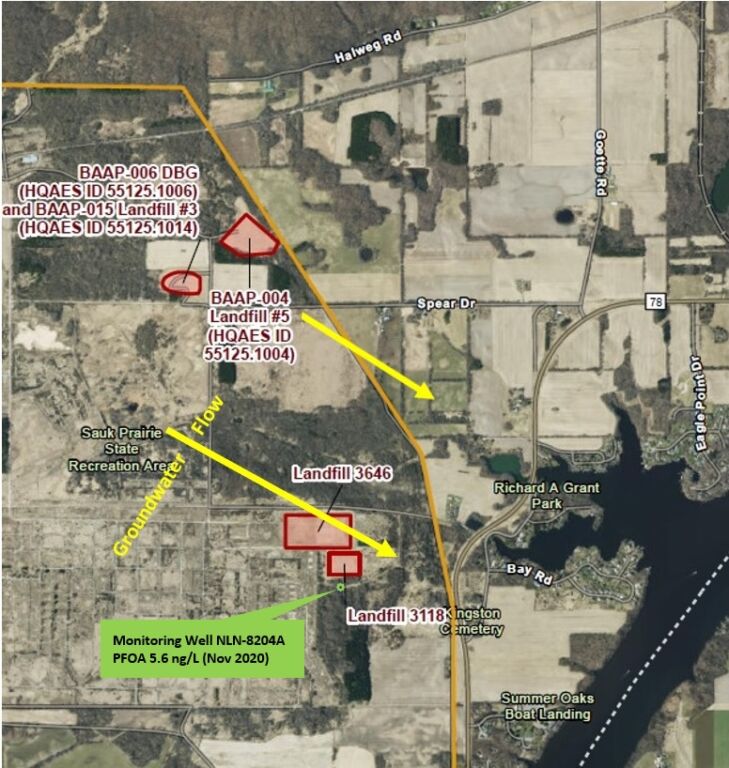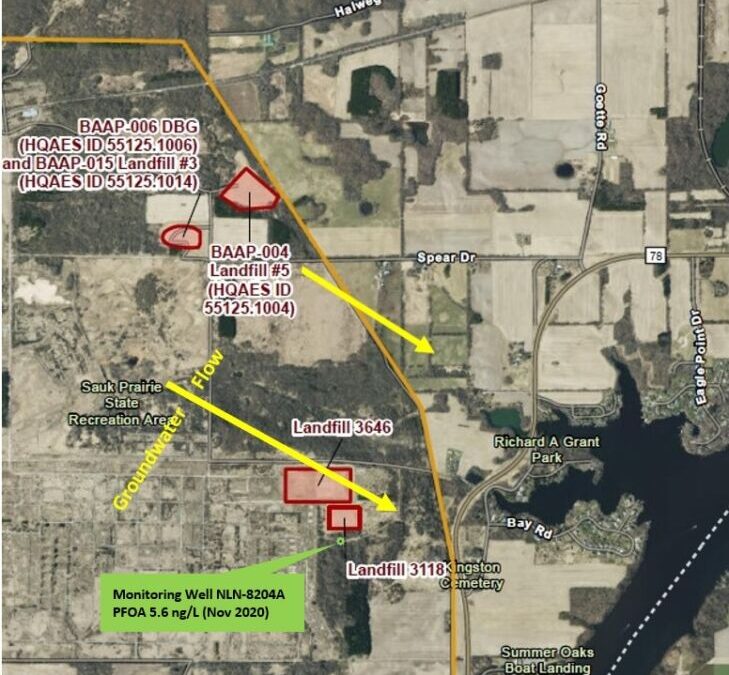
Merrimac Township, WI – The U.S. Army has identified a landfill at the former Badger Army Ammunition Plant as a likely source of PFAS contamination detected in groundwater in the rural Town of Merrimac. Landfill 3646 received soil from the firefighting training area where use of aqueous film-forming foam (AFFF) containing PFAS is suspected, the Army recently reported.[1] AFFFs have been used for fighting liquid fuel fires since the 1970s. Due to its highly toxic nature, several states have passed laws prohibiting the use of AFFF containing PFAS.
As early as November 2020, groundwater samples near the landfill were analyzed for several PFAS (soil samples were not collected). One PFAS compound – perfluorooctanoic acid (PFOA) – was detected at 5.6 parts per trillion (ng/L) in monitoring well NLN-8204A (approximately 800 feet south of the landfill boundary) exceeding the new federal MCL for drinking water.
An MCL (Maximum Contaminant Level) protects public health by setting a maximum level of a contaminant allowed in drinking water which can be delivered to users of a public water systems. In April 2024, EPA proposed an enforceable MCL of 4.0 ng/L for PFOA. The MCL is currently not a promulgated Wisconsin Groundwater Enforcement Standard however the State has clear authority to establish site-specific cleanup goals consistent with these MCLs at contaminated sites like the former Badger lands.
Groundwater flow in and near the map area (above) is generally to the southeast toward the Wisconsin River near Weigand’s Bay.[2][3] This differs from the regional north to south groundwater flow direction.[4]
In 2018, more than 100 people, including members of the local Restoration Advisory Board, co-signed a resolution organized by CSWAB asking that the Army test all public and private drinking water systems within a four-mile radius of Badger for PFAS. The resolution also asked that the Army include PFAS analysis in its then-upcoming testing of approximately 300 residential wells near the former military base. To date, the Army has refused to conduct the requested testing for PFAS beyond the old plant fenceline.[5]
Landfill 3646 is only ONE of dozens of known or suspected sources of PFAS contamination at the former Badger Army Ammunition Plant.
Contamination Risks Remain at Gruber’s Grove Bay on Lake Wisconsin

Sumpter Township, WI – Mercury-contaminated sediment remains in Gruber’s Grove Bay after two rounds of dredging by the U.S. Army at Badger Army Ammunition Plant. Concentrations of mercury currently exceed both the cleanup level of 0.36 milligrams/kilogram (mg/kg) and the not-to-exceed level of 1.5 mg/kg required by the Wisconsin Department of Natural Resources. Based on samples collected in 2018, an estimated 54,120 cubic yards of contaminated sediment remains over 17.27 acres within the bay. This contamination is an ongoing potential source of adverse effects for ecological receptors, the Army recently reported.[6]
During active production years, Badger Army Ammunition Plant discharged wastewater to Gruber’s Grove Bay of Lake Wisconsin resulting in the contamination of lake bottom sediments. In addition to mercury, sediment contaminants include lead, copper, arsenic, ammonia, nitroglycerine, PCBs, and methylmercury.[7]
Available aerial photographs (circa 2023) show an increase in the number of private docks on Gruber’s Grove Bay and a newly constructed home on the southern boundary of Gruber’s Grove Bay has created a man-made beach along the shoreline, the Army said.[8]
The Army also reports that while the Wisconsin Department of Natural Resources (WDNR) has a fish advisory, it is “unclear how the advisory communicates the potential exposure of human receptors to mercury from Gruber’s Grove Bay via the food chain pathway to local residents which affects both current and future protectiveness of human health and the environment.” [9]
According to the Army’s own reports, there is an immediate need for Army to coordinate with WDNR to determine how potential risks associated with human consumption of fish from Gruber’s Grove Bay and the vicinity are communicated to the public.[10] In particular, the current remedy does not address the potential exposure of human receptors to mercury from Gruber’s Grove Bay via the food chain pathway that was identified as a potential route of exposure in previous decision documents. [11]
Upcoming Public Meetings on Environmental Cleanup
Sauk City, WI – The next public meeting of the Badger Restoration Advisory Board will be on Thursday July 18, 2024 at 6:00 p.m.
The meeting will be held at the George Culver Community Library at 615 Phillips Blvd., in Sauk City and virtually using meeting software. You do not have to download the software to participate online (you can access through your browser). You may also call in with a telephone. If you are a RAB member you will receive an invite with the call in and meeting information.
The meeting is open to the public. If you are not a RAB member but would like to participate, please contact Cathy Kropp at 443-243-0313 or Cathryn.L.Kropp.civ@army.mil and she will provide information on how to join the virtual meeting.
Future meetings planned for Oct. 17, 2024 and Jan.18, Apr. 17, and July 17, 2025.
[1] United States Army Environmental Command, DRAFT Final Second Five-Year Review Report, Badger Army Ammunition Plant, unsigned.
[2] Warzyn Engineering, Inc., 1982. Closure Plan, Deterrent Burning Grounds, Badger Army Ammunition Plant, Baraboo, Wisconsin. September 24.
[3] U.S. Army Environmental Center, PFAS Preliminary Assessment/Site Inspection, Badger Army Ammunition Plant, Figure D-3, Landfill 3646 AOPI, PFOS, PFOA and PFBS Analytical Results, 2020.
[4] Stone and Webster, Inc., 2002. Draft Alternative Feasibility Study, Deterrent Burning Ground Waste Pits Subsurface Soil, Badger Army Ammunition Plant, Baraboo, Wisconsin, Revision 3.
[5] Citizens for Safe Water Around Badger, PFAS Renewed Concern at Badger Ammo, Aug 22, 2022. Online at https://cswab.org/pfas-renewed-concern-at-badger-ammo/
[6] United States Army Environmental Command, DRAFT Final Second Five-Year Review Report, Badger Army Ammunition Plant, unsigned.
[7] U.S. Army Environmental Command, Gruber’s Grove Bay Sediment Sampling Report, March 2019.
[8] United States Army Environmental Command, DRAFT Final Second Five-Year Review Report, Badger Army Ammunition Plant, Appendix B, unsigned.
[9] United States Army Environmental Command, DRAFT Final Second Five-Year Review Report, Badger Army Ammunition Plant, Table 20, unsigned.
[10] United States Army Environmental Command, FINAL Second Five-Year Review Report, Section 6.9 RECOMMENDATIONS AND FOLLOW-UP ACTIONS, published 11 April 2024.
[11] United States Army Environmental Command, FINAL Second Five-Year Review Report, Section 6.9 RECOMMENDATIONS AND FOLLOW-UP ACTIONS, published 11 April 2024.

